Digital Marketing Analysis: Boo.com's Failure and Modern Strategies
VerifiedAdded on 2021/01/02
|14
|4285
|365
Report
AI Summary
This report examines the importance of digital marketing in contemporary business by analyzing the failure of Boo.com, an online global sports retail site launched in 1999. The report highlights the key differences between traditional and digital marketing, emphasizing digital marketing's advantages in communication, cost-effectiveness, and data analytics. It explores web optimization techniques, including code minification and compression, and discusses the significance of SEO, SMM, and content marketing in attracting, retaining, and engaging customers. The report also delves into PPC and online display advertising, outlining the steps to design effective campaigns. The analysis underscores the importance of adapting to digital strategies to avoid the pitfalls that led to Boo.com's downfall, emphasizing the necessity of market research, web performance, and data-driven decision-making.
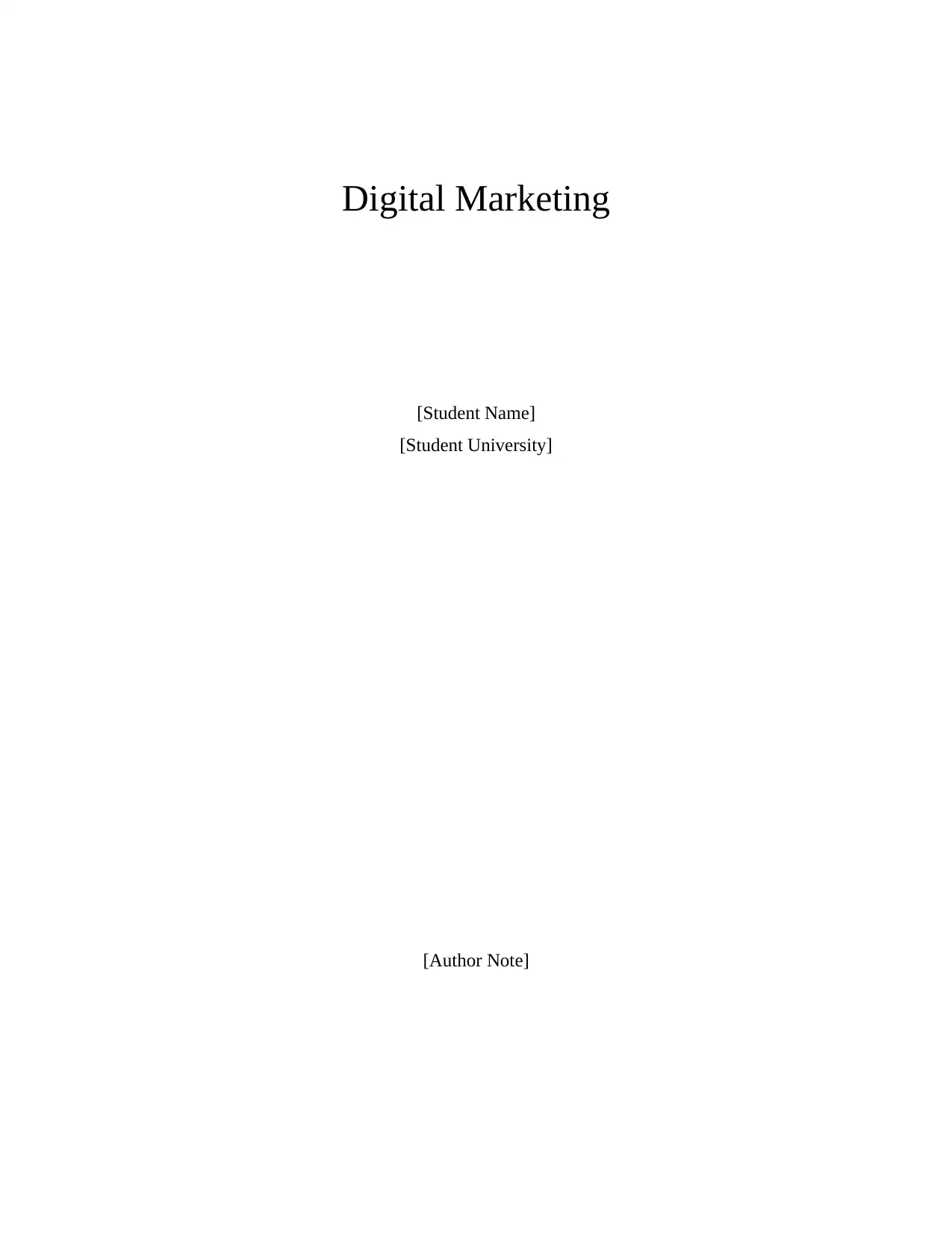
Digital Marketing
[Student Name]
[Student University]
[Author Note]
[Student Name]
[Student University]
[Author Note]
Paraphrase This Document
Need a fresh take? Get an instant paraphrase of this document with our AI Paraphraser
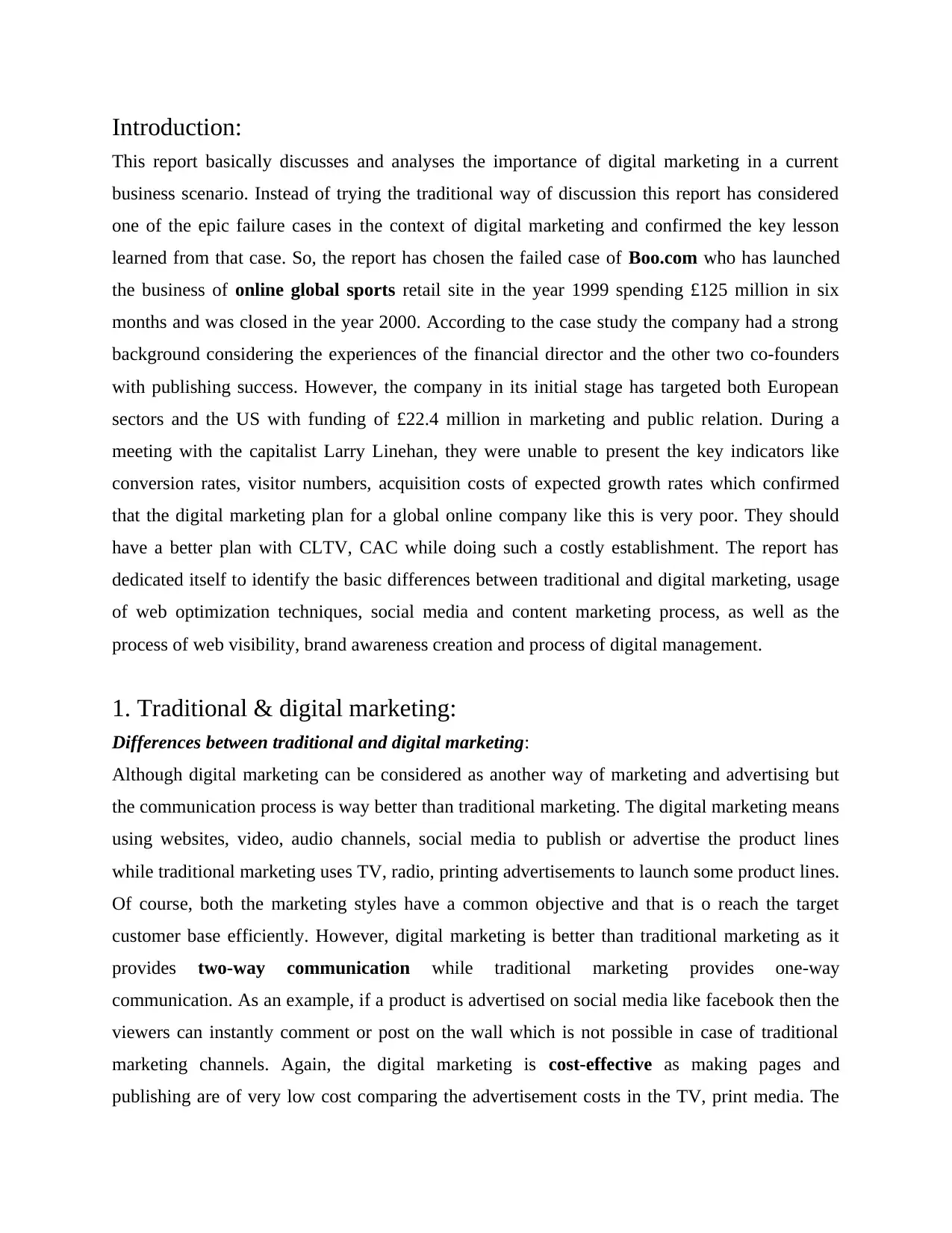
Introduction:
This report basically discusses and analyses the importance of digital marketing in a current
business scenario. Instead of trying the traditional way of discussion this report has considered
one of the epic failure cases in the context of digital marketing and confirmed the key lesson
learned from that case. So, the report has chosen the failed case of Boo.com who has launched
the business of online global sports retail site in the year 1999 spending £125 million in six
months and was closed in the year 2000. According to the case study the company had a strong
background considering the experiences of the financial director and the other two co-founders
with publishing success. However, the company in its initial stage has targeted both European
sectors and the US with funding of £22.4 million in marketing and public relation. During a
meeting with the capitalist Larry Linehan, they were unable to present the key indicators like
conversion rates, visitor numbers, acquisition costs of expected growth rates which confirmed
that the digital marketing plan for a global online company like this is very poor. They should
have a better plan with CLTV, CAC while doing such a costly establishment. The report has
dedicated itself to identify the basic differences between traditional and digital marketing, usage
of web optimization techniques, social media and content marketing process, as well as the
process of web visibility, brand awareness creation and process of digital management.
1. Traditional & digital marketing:
Differences between traditional and digital marketing:
Although digital marketing can be considered as another way of marketing and advertising but
the communication process is way better than traditional marketing. The digital marketing means
using websites, video, audio channels, social media to publish or advertise the product lines
while traditional marketing uses TV, radio, printing advertisements to launch some product lines.
Of course, both the marketing styles have a common objective and that is o reach the target
customer base efficiently. However, digital marketing is better than traditional marketing as it
provides two-way communication while traditional marketing provides one-way
communication. As an example, if a product is advertised on social media like facebook then the
viewers can instantly comment or post on the wall which is not possible in case of traditional
marketing channels. Again, the digital marketing is cost-effective as making pages and
publishing are of very low cost comparing the advertisement costs in the TV, print media. The
This report basically discusses and analyses the importance of digital marketing in a current
business scenario. Instead of trying the traditional way of discussion this report has considered
one of the epic failure cases in the context of digital marketing and confirmed the key lesson
learned from that case. So, the report has chosen the failed case of Boo.com who has launched
the business of online global sports retail site in the year 1999 spending £125 million in six
months and was closed in the year 2000. According to the case study the company had a strong
background considering the experiences of the financial director and the other two co-founders
with publishing success. However, the company in its initial stage has targeted both European
sectors and the US with funding of £22.4 million in marketing and public relation. During a
meeting with the capitalist Larry Linehan, they were unable to present the key indicators like
conversion rates, visitor numbers, acquisition costs of expected growth rates which confirmed
that the digital marketing plan for a global online company like this is very poor. They should
have a better plan with CLTV, CAC while doing such a costly establishment. The report has
dedicated itself to identify the basic differences between traditional and digital marketing, usage
of web optimization techniques, social media and content marketing process, as well as the
process of web visibility, brand awareness creation and process of digital management.
1. Traditional & digital marketing:
Differences between traditional and digital marketing:
Although digital marketing can be considered as another way of marketing and advertising but
the communication process is way better than traditional marketing. The digital marketing means
using websites, video, audio channels, social media to publish or advertise the product lines
while traditional marketing uses TV, radio, printing advertisements to launch some product lines.
Of course, both the marketing styles have a common objective and that is o reach the target
customer base efficiently. However, digital marketing is better than traditional marketing as it
provides two-way communication while traditional marketing provides one-way
communication. As an example, if a product is advertised on social media like facebook then the
viewers can instantly comment or post on the wall which is not possible in case of traditional
marketing channels. Again, the digital marketing is cost-effective as making pages and
publishing are of very low cost comparing the advertisement costs in the TV, print media. The
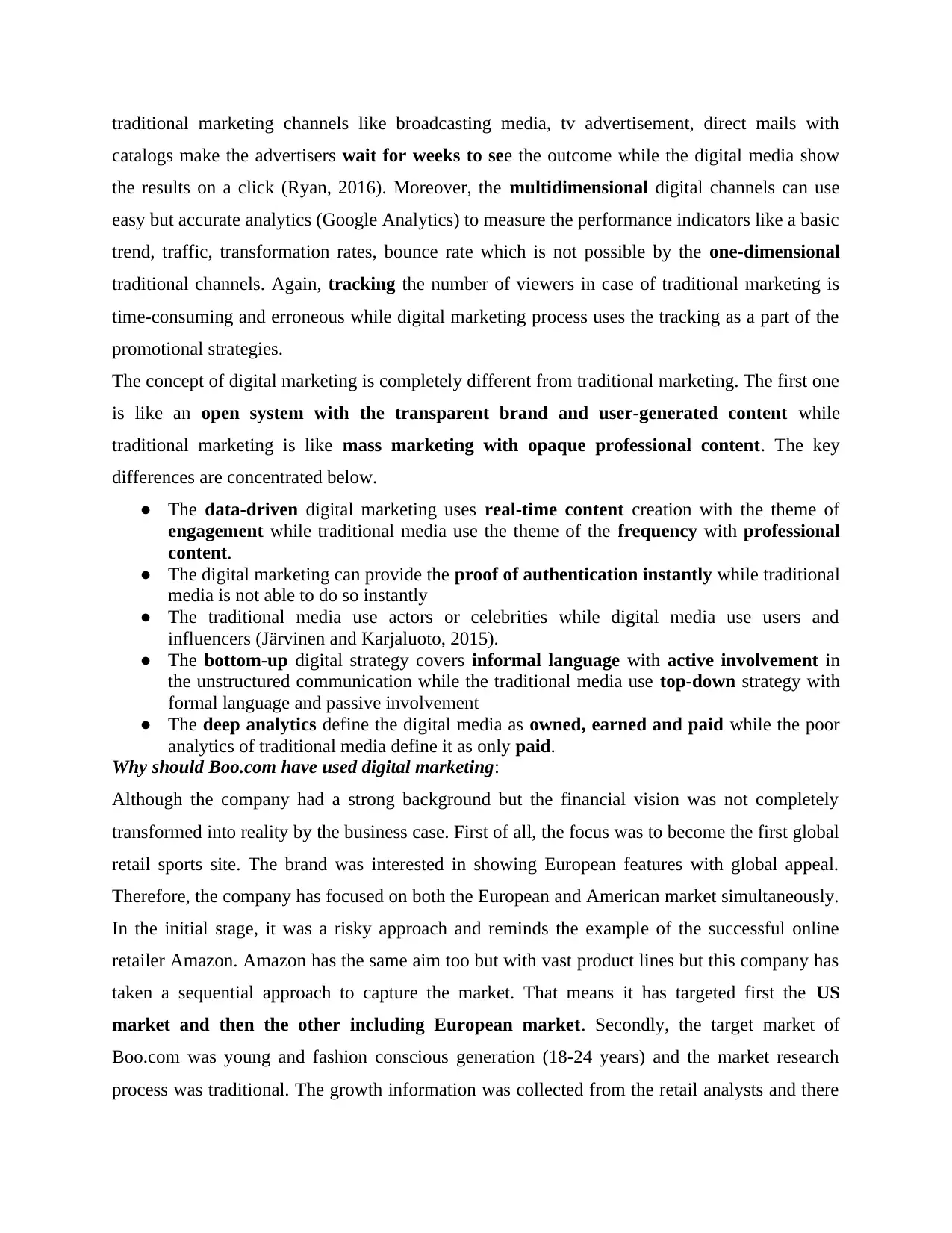
traditional marketing channels like broadcasting media, tv advertisement, direct mails with
catalogs make the advertisers wait for weeks to see the outcome while the digital media show
the results on a click (Ryan, 2016). Moreover, the multidimensional digital channels can use
easy but accurate analytics (Google Analytics) to measure the performance indicators like a basic
trend, traffic, transformation rates, bounce rate which is not possible by the one-dimensional
traditional channels. Again, tracking the number of viewers in case of traditional marketing is
time-consuming and erroneous while digital marketing process uses the tracking as a part of the
promotional strategies.
The concept of digital marketing is completely different from traditional marketing. The first one
is like an open system with the transparent brand and user-generated content while
traditional marketing is like mass marketing with opaque professional content. The key
differences are concentrated below.
● The data-driven digital marketing uses real-time content creation with the theme of
engagement while traditional media use the theme of the frequency with professional
content.
● The digital marketing can provide the proof of authentication instantly while traditional
media is not able to do so instantly
● The traditional media use actors or celebrities while digital media use users and
influencers (Järvinen and Karjaluoto, 2015).
● The bottom-up digital strategy covers informal language with active involvement in
the unstructured communication while the traditional media use top-down strategy with
formal language and passive involvement
● The deep analytics define the digital media as owned, earned and paid while the poor
analytics of traditional media define it as only paid.
Why should Boo.com have used digital marketing:
Although the company had a strong background but the financial vision was not completely
transformed into reality by the business case. First of all, the focus was to become the first global
retail sports site. The brand was interested in showing European features with global appeal.
Therefore, the company has focused on both the European and American market simultaneously.
In the initial stage, it was a risky approach and reminds the example of the successful online
retailer Amazon. Amazon has the same aim too but with vast product lines but this company has
taken a sequential approach to capture the market. That means it has targeted first the US
market and then the other including European market. Secondly, the target market of
Boo.com was young and fashion conscious generation (18-24 years) and the market research
process was traditional. The growth information was collected from the retail analysts and there
catalogs make the advertisers wait for weeks to see the outcome while the digital media show
the results on a click (Ryan, 2016). Moreover, the multidimensional digital channels can use
easy but accurate analytics (Google Analytics) to measure the performance indicators like a basic
trend, traffic, transformation rates, bounce rate which is not possible by the one-dimensional
traditional channels. Again, tracking the number of viewers in case of traditional marketing is
time-consuming and erroneous while digital marketing process uses the tracking as a part of the
promotional strategies.
The concept of digital marketing is completely different from traditional marketing. The first one
is like an open system with the transparent brand and user-generated content while
traditional marketing is like mass marketing with opaque professional content. The key
differences are concentrated below.
● The data-driven digital marketing uses real-time content creation with the theme of
engagement while traditional media use the theme of the frequency with professional
content.
● The digital marketing can provide the proof of authentication instantly while traditional
media is not able to do so instantly
● The traditional media use actors or celebrities while digital media use users and
influencers (Järvinen and Karjaluoto, 2015).
● The bottom-up digital strategy covers informal language with active involvement in
the unstructured communication while the traditional media use top-down strategy with
formal language and passive involvement
● The deep analytics define the digital media as owned, earned and paid while the poor
analytics of traditional media define it as only paid.
Why should Boo.com have used digital marketing:
Although the company had a strong background but the financial vision was not completely
transformed into reality by the business case. First of all, the focus was to become the first global
retail sports site. The brand was interested in showing European features with global appeal.
Therefore, the company has focused on both the European and American market simultaneously.
In the initial stage, it was a risky approach and reminds the example of the successful online
retailer Amazon. Amazon has the same aim too but with vast product lines but this company has
taken a sequential approach to capture the market. That means it has targeted first the US
market and then the other including European market. Secondly, the target market of
Boo.com was young and fashion conscious generation (18-24 years) and the market research
process was traditional. The growth information was collected from the retail analysts and there
⊘ This is a preview!⊘
Do you want full access?
Subscribe today to unlock all pages.

Trusted by 1+ million students worldwide
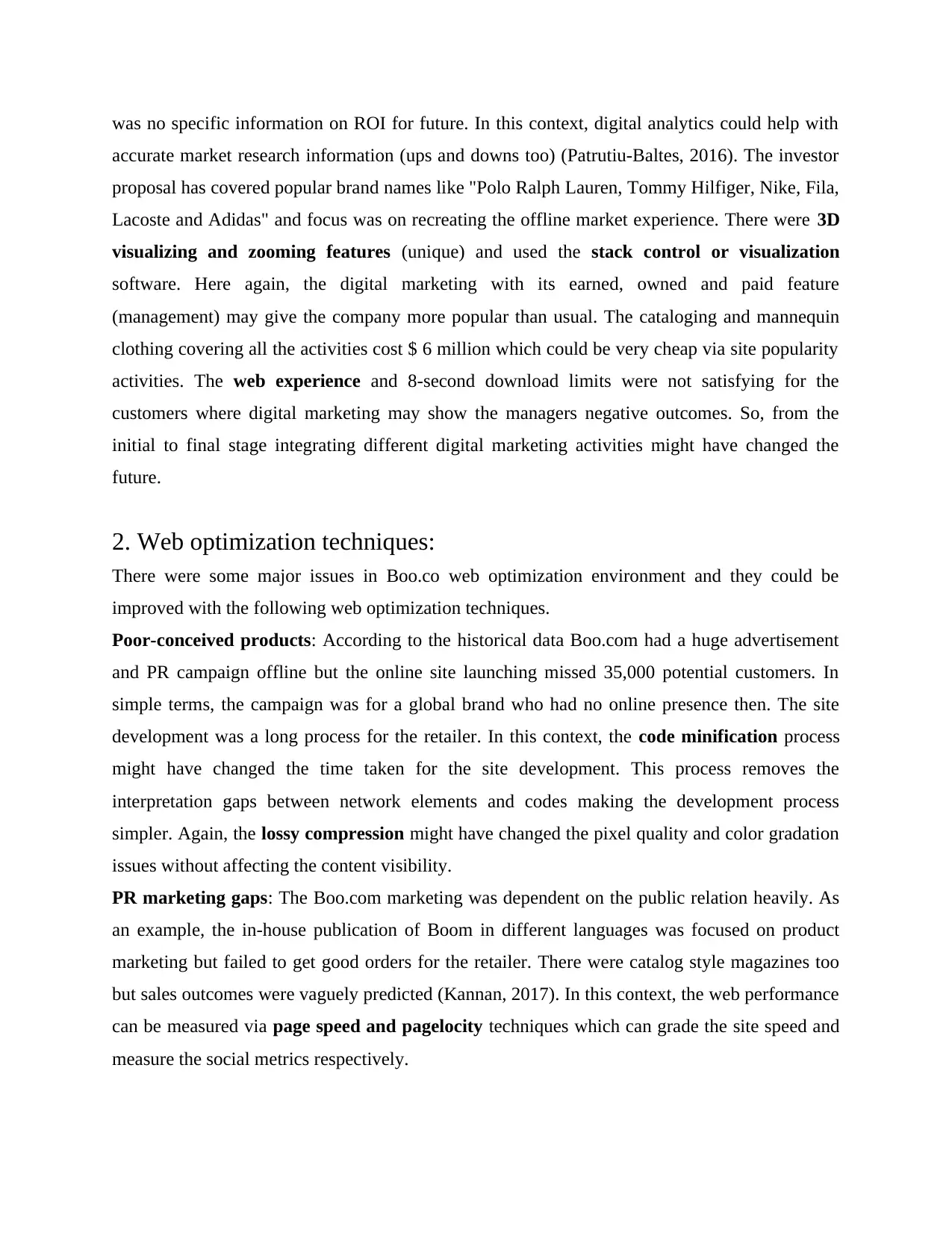
was no specific information on ROI for future. In this context, digital analytics could help with
accurate market research information (ups and downs too) (Patrutiu-Baltes, 2016). The investor
proposal has covered popular brand names like "Polo Ralph Lauren, Tommy Hilfiger, Nike, Fila,
Lacoste and Adidas" and focus was on recreating the offline market experience. There were 3D
visualizing and zooming features (unique) and used the stack control or visualization
software. Here again, the digital marketing with its earned, owned and paid feature
(management) may give the company more popular than usual. The cataloging and mannequin
clothing covering all the activities cost $ 6 million which could be very cheap via site popularity
activities. The web experience and 8-second download limits were not satisfying for the
customers where digital marketing may show the managers negative outcomes. So, from the
initial to final stage integrating different digital marketing activities might have changed the
future.
2. Web optimization techniques:
There were some major issues in Boo.co web optimization environment and they could be
improved with the following web optimization techniques.
Poor-conceived products: According to the historical data Boo.com had a huge advertisement
and PR campaign offline but the online site launching missed 35,000 potential customers. In
simple terms, the campaign was for a global brand who had no online presence then. The site
development was a long process for the retailer. In this context, the code minification process
might have changed the time taken for the site development. This process removes the
interpretation gaps between network elements and codes making the development process
simpler. Again, the lossy compression might have changed the pixel quality and color gradation
issues without affecting the content visibility.
PR marketing gaps: The Boo.com marketing was dependent on the public relation heavily. As
an example, the in-house publication of Boom in different languages was focused on product
marketing but failed to get good orders for the retailer. There were catalog style magazines too
but sales outcomes were vaguely predicted (Kannan, 2017). In this context, the web performance
can be measured via page speed and pagelocity techniques which can grade the site speed and
measure the social metrics respectively.
accurate market research information (ups and downs too) (Patrutiu-Baltes, 2016). The investor
proposal has covered popular brand names like "Polo Ralph Lauren, Tommy Hilfiger, Nike, Fila,
Lacoste and Adidas" and focus was on recreating the offline market experience. There were 3D
visualizing and zooming features (unique) and used the stack control or visualization
software. Here again, the digital marketing with its earned, owned and paid feature
(management) may give the company more popular than usual. The cataloging and mannequin
clothing covering all the activities cost $ 6 million which could be very cheap via site popularity
activities. The web experience and 8-second download limits were not satisfying for the
customers where digital marketing may show the managers negative outcomes. So, from the
initial to final stage integrating different digital marketing activities might have changed the
future.
2. Web optimization techniques:
There were some major issues in Boo.co web optimization environment and they could be
improved with the following web optimization techniques.
Poor-conceived products: According to the historical data Boo.com had a huge advertisement
and PR campaign offline but the online site launching missed 35,000 potential customers. In
simple terms, the campaign was for a global brand who had no online presence then. The site
development was a long process for the retailer. In this context, the code minification process
might have changed the time taken for the site development. This process removes the
interpretation gaps between network elements and codes making the development process
simpler. Again, the lossy compression might have changed the pixel quality and color gradation
issues without affecting the content visibility.
PR marketing gaps: The Boo.com marketing was dependent on the public relation heavily. As
an example, the in-house publication of Boom in different languages was focused on product
marketing but failed to get good orders for the retailer. There were catalog style magazines too
but sales outcomes were vaguely predicted (Kannan, 2017). In this context, the web performance
can be measured via page speed and pagelocity techniques which can grade the site speed and
measure the social metrics respectively.
Paraphrase This Document
Need a fresh take? Get an instant paraphrase of this document with our AI Paraphraser
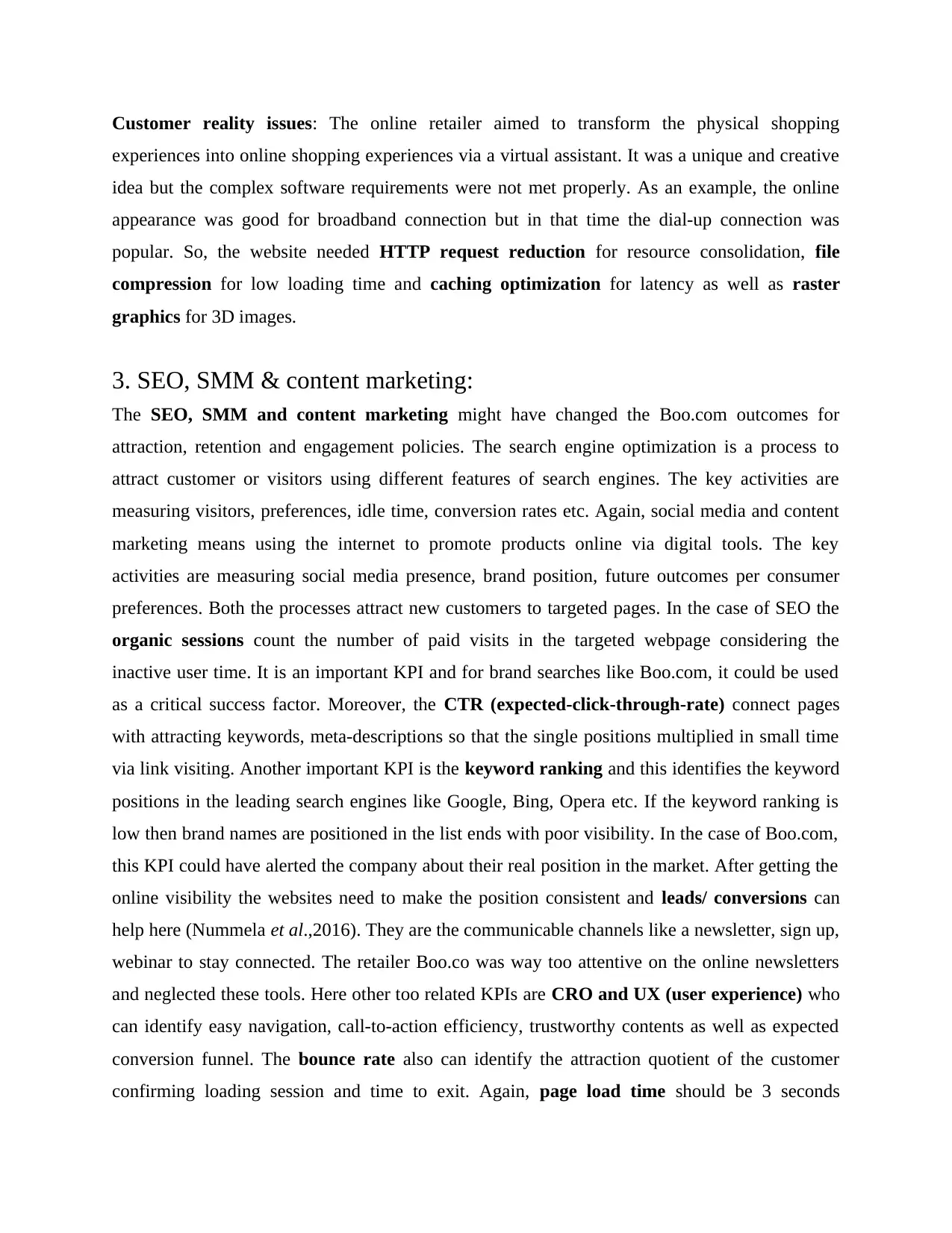
Customer reality issues: The online retailer aimed to transform the physical shopping
experiences into online shopping experiences via a virtual assistant. It was a unique and creative
idea but the complex software requirements were not met properly. As an example, the online
appearance was good for broadband connection but in that time the dial-up connection was
popular. So, the website needed HTTP request reduction for resource consolidation, file
compression for low loading time and caching optimization for latency as well as raster
graphics for 3D images.
3. SEO, SMM & content marketing:
The SEO, SMM and content marketing might have changed the Boo.com outcomes for
attraction, retention and engagement policies. The search engine optimization is a process to
attract customer or visitors using different features of search engines. The key activities are
measuring visitors, preferences, idle time, conversion rates etc. Again, social media and content
marketing means using the internet to promote products online via digital tools. The key
activities are measuring social media presence, brand position, future outcomes per consumer
preferences. Both the processes attract new customers to targeted pages. In the case of SEO the
organic sessions count the number of paid visits in the targeted webpage considering the
inactive user time. It is an important KPI and for brand searches like Boo.com, it could be used
as a critical success factor. Moreover, the CTR (expected-click-through-rate) connect pages
with attracting keywords, meta-descriptions so that the single positions multiplied in small time
via link visiting. Another important KPI is the keyword ranking and this identifies the keyword
positions in the leading search engines like Google, Bing, Opera etc. If the keyword ranking is
low then brand names are positioned in the list ends with poor visibility. In the case of Boo.com,
this KPI could have alerted the company about their real position in the market. After getting the
online visibility the websites need to make the position consistent and leads/ conversions can
help here (Nummela et al.,2016). They are the communicable channels like a newsletter, sign up,
webinar to stay connected. The retailer Boo.co was way too attentive on the online newsletters
and neglected these tools. Here other too related KPIs are CRO and UX (user experience) who
can identify easy navigation, call-to-action efficiency, trustworthy contents as well as expected
conversion funnel. The bounce rate also can identify the attraction quotient of the customer
confirming loading session and time to exit. Again, page load time should be 3 seconds
experiences into online shopping experiences via a virtual assistant. It was a unique and creative
idea but the complex software requirements were not met properly. As an example, the online
appearance was good for broadband connection but in that time the dial-up connection was
popular. So, the website needed HTTP request reduction for resource consolidation, file
compression for low loading time and caching optimization for latency as well as raster
graphics for 3D images.
3. SEO, SMM & content marketing:
The SEO, SMM and content marketing might have changed the Boo.com outcomes for
attraction, retention and engagement policies. The search engine optimization is a process to
attract customer or visitors using different features of search engines. The key activities are
measuring visitors, preferences, idle time, conversion rates etc. Again, social media and content
marketing means using the internet to promote products online via digital tools. The key
activities are measuring social media presence, brand position, future outcomes per consumer
preferences. Both the processes attract new customers to targeted pages. In the case of SEO the
organic sessions count the number of paid visits in the targeted webpage considering the
inactive user time. It is an important KPI and for brand searches like Boo.com, it could be used
as a critical success factor. Moreover, the CTR (expected-click-through-rate) connect pages
with attracting keywords, meta-descriptions so that the single positions multiplied in small time
via link visiting. Another important KPI is the keyword ranking and this identifies the keyword
positions in the leading search engines like Google, Bing, Opera etc. If the keyword ranking is
low then brand names are positioned in the list ends with poor visibility. In the case of Boo.com,
this KPI could have alerted the company about their real position in the market. After getting the
online visibility the websites need to make the position consistent and leads/ conversions can
help here (Nummela et al.,2016). They are the communicable channels like a newsletter, sign up,
webinar to stay connected. The retailer Boo.co was way too attentive on the online newsletters
and neglected these tools. Here other too related KPIs are CRO and UX (user experience) who
can identify easy navigation, call-to-action efficiency, trustworthy contents as well as expected
conversion funnel. The bounce rate also can identify the attraction quotient of the customer
confirming loading session and time to exit. Again, page load time should be 3 seconds
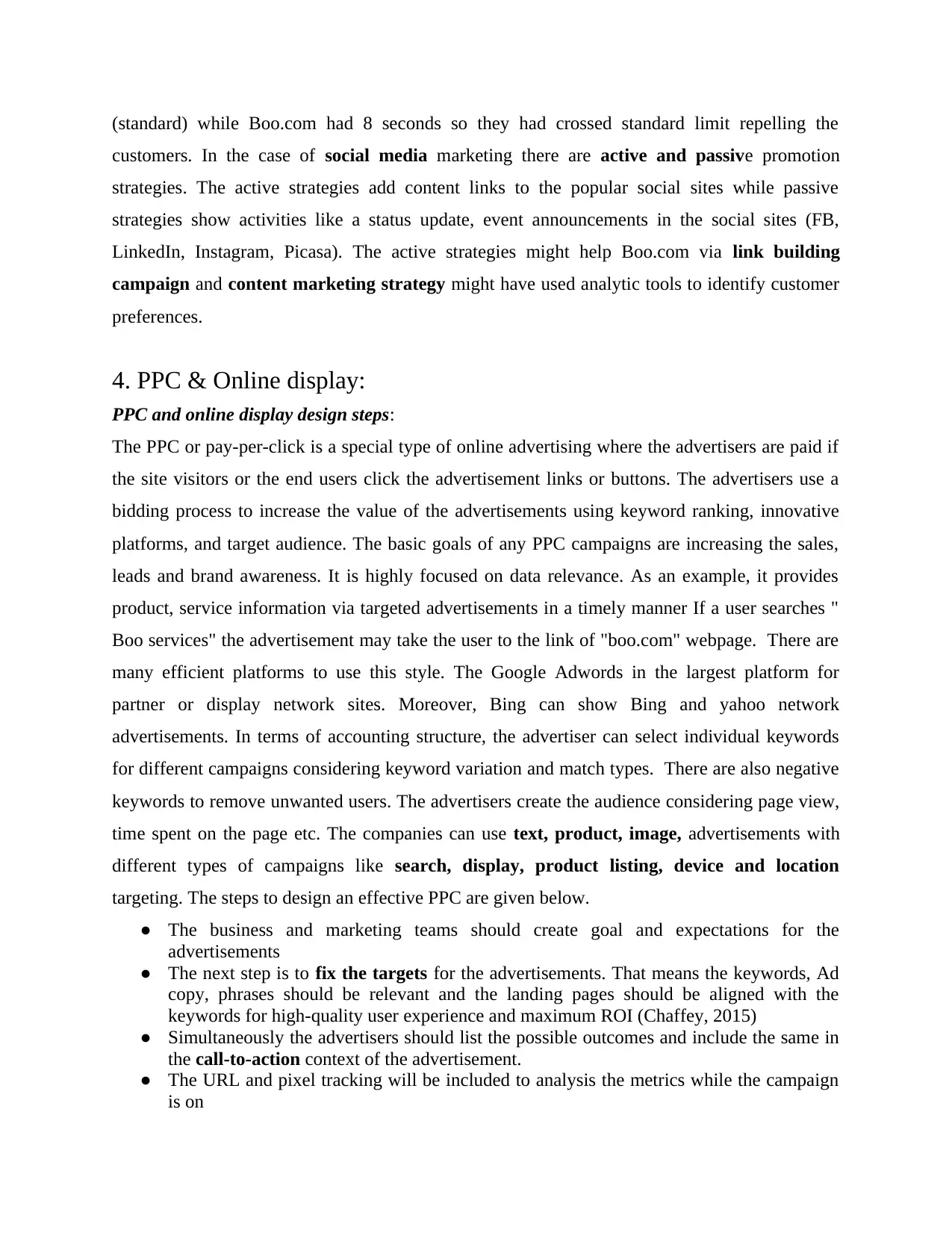
(standard) while Boo.com had 8 seconds so they had crossed standard limit repelling the
customers. In the case of social media marketing there are active and passive promotion
strategies. The active strategies add content links to the popular social sites while passive
strategies show activities like a status update, event announcements in the social sites (FB,
LinkedIn, Instagram, Picasa). The active strategies might help Boo.com via link building
campaign and content marketing strategy might have used analytic tools to identify customer
preferences.
4. PPC & Online display:
PPC and online display design steps:
The PPC or pay-per-click is a special type of online advertising where the advertisers are paid if
the site visitors or the end users click the advertisement links or buttons. The advertisers use a
bidding process to increase the value of the advertisements using keyword ranking, innovative
platforms, and target audience. The basic goals of any PPC campaigns are increasing the sales,
leads and brand awareness. It is highly focused on data relevance. As an example, it provides
product, service information via targeted advertisements in a timely manner If a user searches "
Boo services" the advertisement may take the user to the link of "boo.com" webpage. There are
many efficient platforms to use this style. The Google Adwords in the largest platform for
partner or display network sites. Moreover, Bing can show Bing and yahoo network
advertisements. In terms of accounting structure, the advertiser can select individual keywords
for different campaigns considering keyword variation and match types. There are also negative
keywords to remove unwanted users. The advertisers create the audience considering page view,
time spent on the page etc. The companies can use text, product, image, advertisements with
different types of campaigns like search, display, product listing, device and location
targeting. The steps to design an effective PPC are given below.
● The business and marketing teams should create goal and expectations for the
advertisements
● The next step is to fix the targets for the advertisements. That means the keywords, Ad
copy, phrases should be relevant and the landing pages should be aligned with the
keywords for high-quality user experience and maximum ROI (Chaffey, 2015)
● Simultaneously the advertisers should list the possible outcomes and include the same in
the call-to-action context of the advertisement.
● The URL and pixel tracking will be included to analysis the metrics while the campaign
is on
customers. In the case of social media marketing there are active and passive promotion
strategies. The active strategies add content links to the popular social sites while passive
strategies show activities like a status update, event announcements in the social sites (FB,
LinkedIn, Instagram, Picasa). The active strategies might help Boo.com via link building
campaign and content marketing strategy might have used analytic tools to identify customer
preferences.
4. PPC & Online display:
PPC and online display design steps:
The PPC or pay-per-click is a special type of online advertising where the advertisers are paid if
the site visitors or the end users click the advertisement links or buttons. The advertisers use a
bidding process to increase the value of the advertisements using keyword ranking, innovative
platforms, and target audience. The basic goals of any PPC campaigns are increasing the sales,
leads and brand awareness. It is highly focused on data relevance. As an example, it provides
product, service information via targeted advertisements in a timely manner If a user searches "
Boo services" the advertisement may take the user to the link of "boo.com" webpage. There are
many efficient platforms to use this style. The Google Adwords in the largest platform for
partner or display network sites. Moreover, Bing can show Bing and yahoo network
advertisements. In terms of accounting structure, the advertiser can select individual keywords
for different campaigns considering keyword variation and match types. There are also negative
keywords to remove unwanted users. The advertisers create the audience considering page view,
time spent on the page etc. The companies can use text, product, image, advertisements with
different types of campaigns like search, display, product listing, device and location
targeting. The steps to design an effective PPC are given below.
● The business and marketing teams should create goal and expectations for the
advertisements
● The next step is to fix the targets for the advertisements. That means the keywords, Ad
copy, phrases should be relevant and the landing pages should be aligned with the
keywords for high-quality user experience and maximum ROI (Chaffey, 2015)
● Simultaneously the advertisers should list the possible outcomes and include the same in
the call-to-action context of the advertisement.
● The URL and pixel tracking will be included to analysis the metrics while the campaign
is on
⊘ This is a preview!⊘
Do you want full access?
Subscribe today to unlock all pages.

Trusted by 1+ million students worldwide
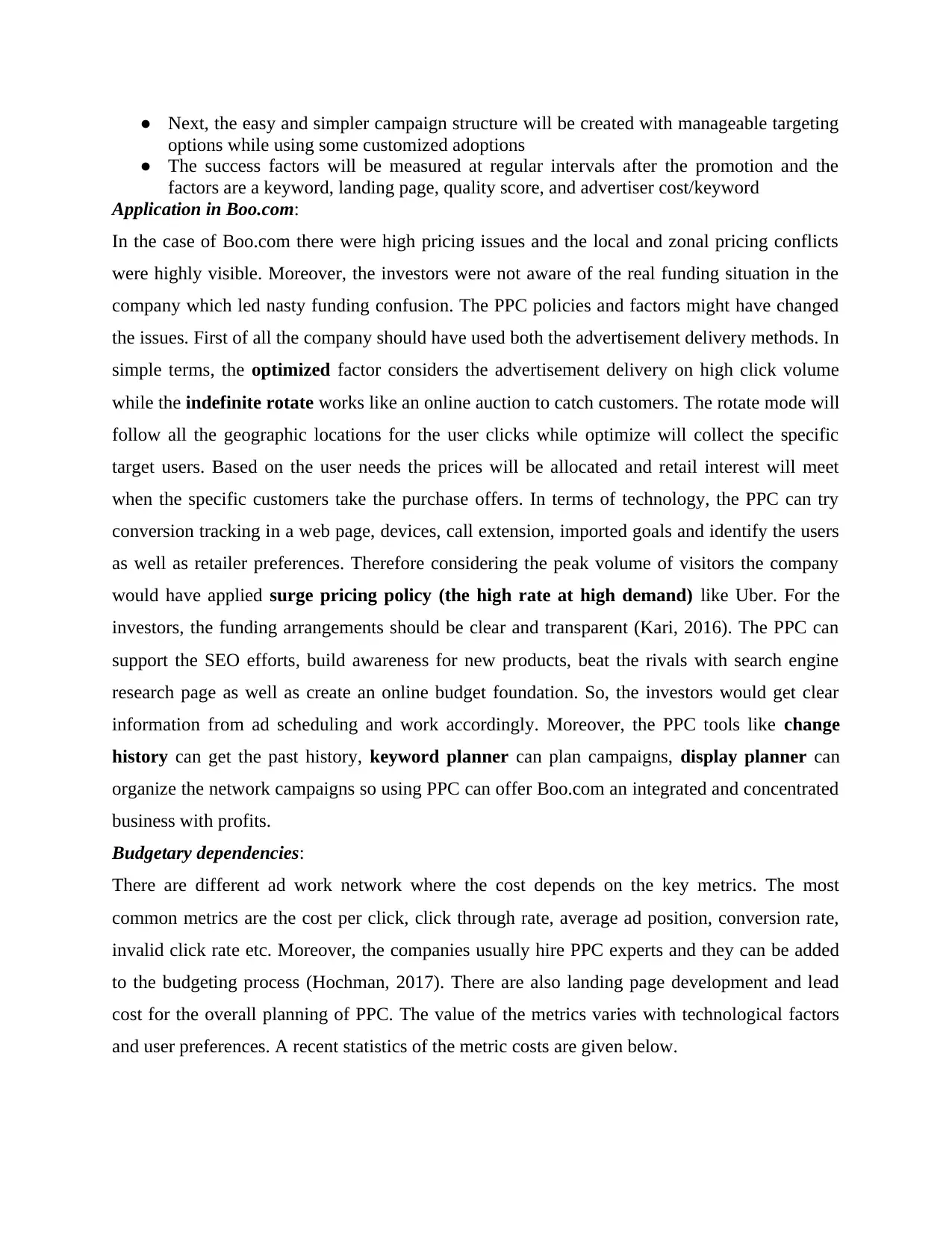
● Next, the easy and simpler campaign structure will be created with manageable targeting
options while using some customized adoptions
● The success factors will be measured at regular intervals after the promotion and the
factors are a keyword, landing page, quality score, and advertiser cost/keyword
Application in Boo.com:
In the case of Boo.com there were high pricing issues and the local and zonal pricing conflicts
were highly visible. Moreover, the investors were not aware of the real funding situation in the
company which led nasty funding confusion. The PPC policies and factors might have changed
the issues. First of all the company should have used both the advertisement delivery methods. In
simple terms, the optimized factor considers the advertisement delivery on high click volume
while the indefinite rotate works like an online auction to catch customers. The rotate mode will
follow all the geographic locations for the user clicks while optimize will collect the specific
target users. Based on the user needs the prices will be allocated and retail interest will meet
when the specific customers take the purchase offers. In terms of technology, the PPC can try
conversion tracking in a web page, devices, call extension, imported goals and identify the users
as well as retailer preferences. Therefore considering the peak volume of visitors the company
would have applied surge pricing policy (the high rate at high demand) like Uber. For the
investors, the funding arrangements should be clear and transparent (Kari, 2016). The PPC can
support the SEO efforts, build awareness for new products, beat the rivals with search engine
research page as well as create an online budget foundation. So, the investors would get clear
information from ad scheduling and work accordingly. Moreover, the PPC tools like change
history can get the past history, keyword planner can plan campaigns, display planner can
organize the network campaigns so using PPC can offer Boo.com an integrated and concentrated
business with profits.
Budgetary dependencies:
There are different ad work network where the cost depends on the key metrics. The most
common metrics are the cost per click, click through rate, average ad position, conversion rate,
invalid click rate etc. Moreover, the companies usually hire PPC experts and they can be added
to the budgeting process (Hochman, 2017). There are also landing page development and lead
cost for the overall planning of PPC. The value of the metrics varies with technological factors
and user preferences. A recent statistics of the metric costs are given below.
options while using some customized adoptions
● The success factors will be measured at regular intervals after the promotion and the
factors are a keyword, landing page, quality score, and advertiser cost/keyword
Application in Boo.com:
In the case of Boo.com there were high pricing issues and the local and zonal pricing conflicts
were highly visible. Moreover, the investors were not aware of the real funding situation in the
company which led nasty funding confusion. The PPC policies and factors might have changed
the issues. First of all the company should have used both the advertisement delivery methods. In
simple terms, the optimized factor considers the advertisement delivery on high click volume
while the indefinite rotate works like an online auction to catch customers. The rotate mode will
follow all the geographic locations for the user clicks while optimize will collect the specific
target users. Based on the user needs the prices will be allocated and retail interest will meet
when the specific customers take the purchase offers. In terms of technology, the PPC can try
conversion tracking in a web page, devices, call extension, imported goals and identify the users
as well as retailer preferences. Therefore considering the peak volume of visitors the company
would have applied surge pricing policy (the high rate at high demand) like Uber. For the
investors, the funding arrangements should be clear and transparent (Kari, 2016). The PPC can
support the SEO efforts, build awareness for new products, beat the rivals with search engine
research page as well as create an online budget foundation. So, the investors would get clear
information from ad scheduling and work accordingly. Moreover, the PPC tools like change
history can get the past history, keyword planner can plan campaigns, display planner can
organize the network campaigns so using PPC can offer Boo.com an integrated and concentrated
business with profits.
Budgetary dependencies:
There are different ad work network where the cost depends on the key metrics. The most
common metrics are the cost per click, click through rate, average ad position, conversion rate,
invalid click rate etc. Moreover, the companies usually hire PPC experts and they can be added
to the budgeting process (Hochman, 2017). There are also landing page development and lead
cost for the overall planning of PPC. The value of the metrics varies with technological factors
and user preferences. A recent statistics of the metric costs are given below.
Paraphrase This Document
Need a fresh take? Get an instant paraphrase of this document with our AI Paraphraser
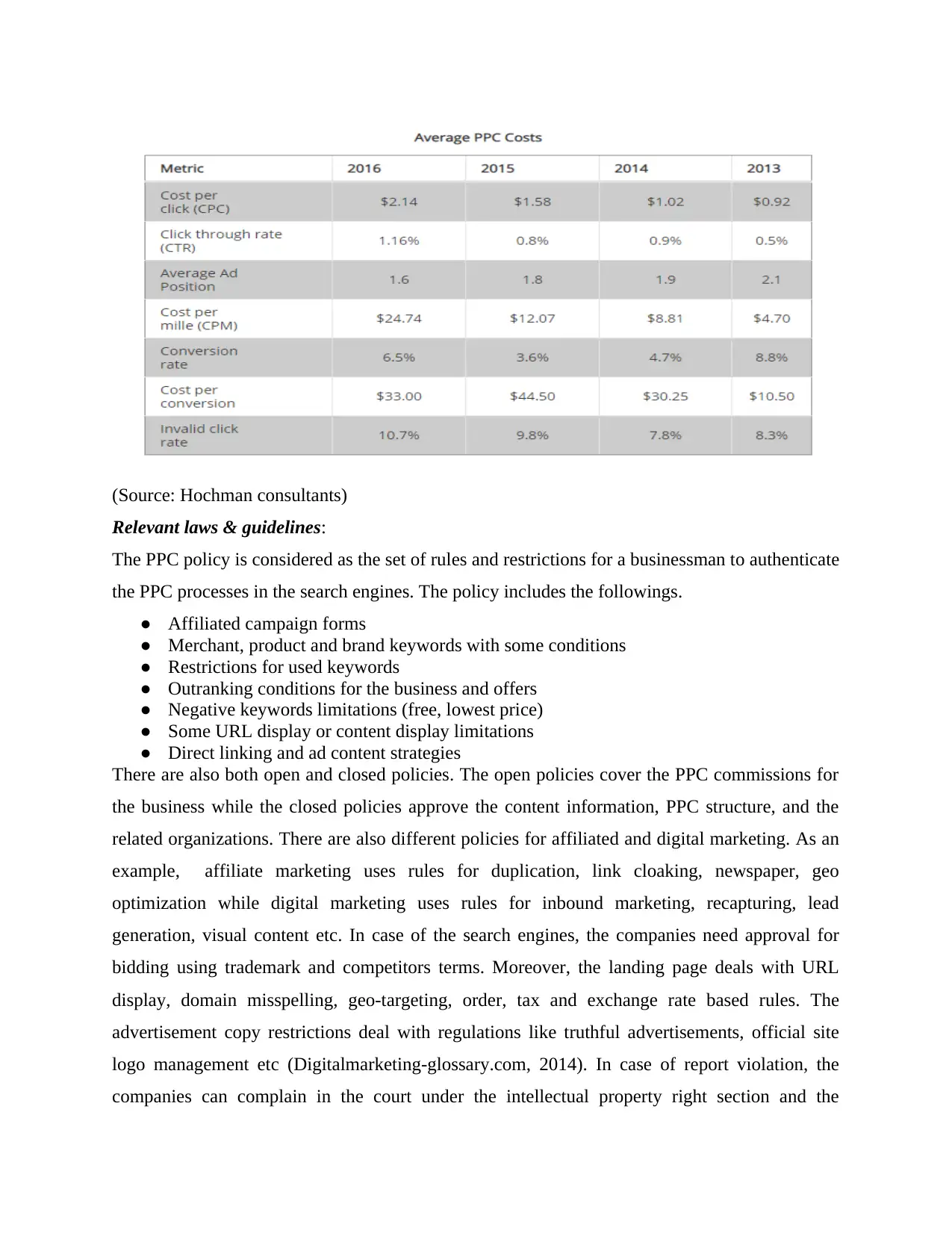
(Source: Hochman consultants)
Relevant laws & guidelines:
The PPC policy is considered as the set of rules and restrictions for a businessman to authenticate
the PPC processes in the search engines. The policy includes the followings.
● Affiliated campaign forms
● Merchant, product and brand keywords with some conditions
● Restrictions for used keywords
● Outranking conditions for the business and offers
● Negative keywords limitations (free, lowest price)
● Some URL display or content display limitations
● Direct linking and ad content strategies
There are also both open and closed policies. The open policies cover the PPC commissions for
the business while the closed policies approve the content information, PPC structure, and the
related organizations. There are also different policies for affiliated and digital marketing. As an
example, affiliate marketing uses rules for duplication, link cloaking, newspaper, geo
optimization while digital marketing uses rules for inbound marketing, recapturing, lead
generation, visual content etc. In case of the search engines, the companies need approval for
bidding using trademark and competitors terms. Moreover, the landing page deals with URL
display, domain misspelling, geo-targeting, order, tax and exchange rate based rules. The
advertisement copy restrictions deal with regulations like truthful advertisements, official site
logo management etc (Digitalmarketing-glossary.com, 2014). In case of report violation, the
companies can complain in the court under the intellectual property right section and the
Relevant laws & guidelines:
The PPC policy is considered as the set of rules and restrictions for a businessman to authenticate
the PPC processes in the search engines. The policy includes the followings.
● Affiliated campaign forms
● Merchant, product and brand keywords with some conditions
● Restrictions for used keywords
● Outranking conditions for the business and offers
● Negative keywords limitations (free, lowest price)
● Some URL display or content display limitations
● Direct linking and ad content strategies
There are also both open and closed policies. The open policies cover the PPC commissions for
the business while the closed policies approve the content information, PPC structure, and the
related organizations. There are also different policies for affiliated and digital marketing. As an
example, affiliate marketing uses rules for duplication, link cloaking, newspaper, geo
optimization while digital marketing uses rules for inbound marketing, recapturing, lead
generation, visual content etc. In case of the search engines, the companies need approval for
bidding using trademark and competitors terms. Moreover, the landing page deals with URL
display, domain misspelling, geo-targeting, order, tax and exchange rate based rules. The
advertisement copy restrictions deal with regulations like truthful advertisements, official site
logo management etc (Digitalmarketing-glossary.com, 2014). In case of report violation, the
companies can complain in the court under the intellectual property right section and the
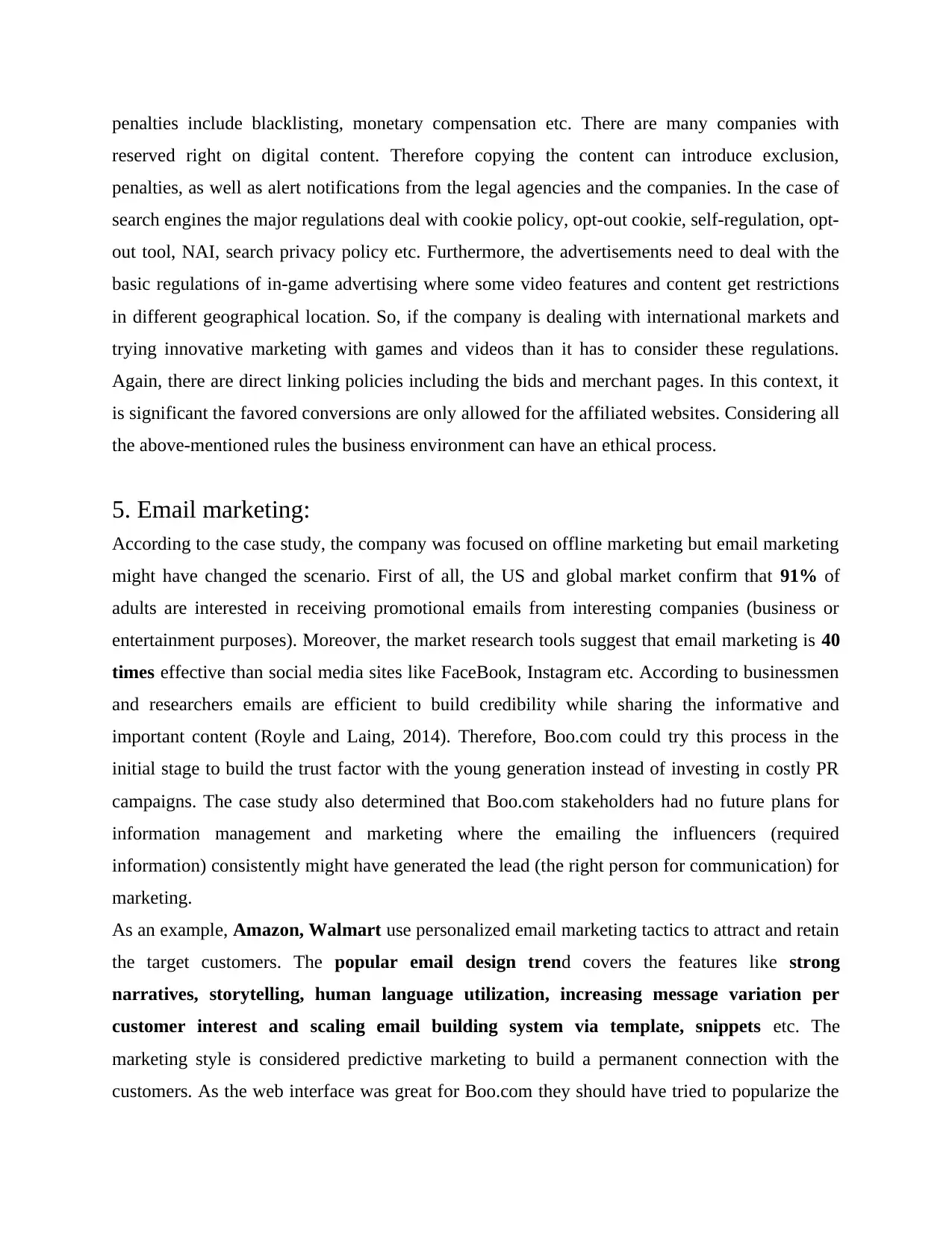
penalties include blacklisting, monetary compensation etc. There are many companies with
reserved right on digital content. Therefore copying the content can introduce exclusion,
penalties, as well as alert notifications from the legal agencies and the companies. In the case of
search engines the major regulations deal with cookie policy, opt-out cookie, self-regulation, opt-
out tool, NAI, search privacy policy etc. Furthermore, the advertisements need to deal with the
basic regulations of in-game advertising where some video features and content get restrictions
in different geographical location. So, if the company is dealing with international markets and
trying innovative marketing with games and videos than it has to consider these regulations.
Again, there are direct linking policies including the bids and merchant pages. In this context, it
is significant the favored conversions are only allowed for the affiliated websites. Considering all
the above-mentioned rules the business environment can have an ethical process.
5. Email marketing:
According to the case study, the company was focused on offline marketing but email marketing
might have changed the scenario. First of all, the US and global market confirm that 91% of
adults are interested in receiving promotional emails from interesting companies (business or
entertainment purposes). Moreover, the market research tools suggest that email marketing is 40
times effective than social media sites like FaceBook, Instagram etc. According to businessmen
and researchers emails are efficient to build credibility while sharing the informative and
important content (Royle and Laing, 2014). Therefore, Boo.com could try this process in the
initial stage to build the trust factor with the young generation instead of investing in costly PR
campaigns. The case study also determined that Boo.com stakeholders had no future plans for
information management and marketing where the emailing the influencers (required
information) consistently might have generated the lead (the right person for communication) for
marketing.
As an example, Amazon, Walmart use personalized email marketing tactics to attract and retain
the target customers. The popular email design trend covers the features like strong
narratives, storytelling, human language utilization, increasing message variation per
customer interest and scaling email building system via template, snippets etc. The
marketing style is considered predictive marketing to build a permanent connection with the
customers. As the web interface was great for Boo.com they should have tried to popularize the
reserved right on digital content. Therefore copying the content can introduce exclusion,
penalties, as well as alert notifications from the legal agencies and the companies. In the case of
search engines the major regulations deal with cookie policy, opt-out cookie, self-regulation, opt-
out tool, NAI, search privacy policy etc. Furthermore, the advertisements need to deal with the
basic regulations of in-game advertising where some video features and content get restrictions
in different geographical location. So, if the company is dealing with international markets and
trying innovative marketing with games and videos than it has to consider these regulations.
Again, there are direct linking policies including the bids and merchant pages. In this context, it
is significant the favored conversions are only allowed for the affiliated websites. Considering all
the above-mentioned rules the business environment can have an ethical process.
5. Email marketing:
According to the case study, the company was focused on offline marketing but email marketing
might have changed the scenario. First of all, the US and global market confirm that 91% of
adults are interested in receiving promotional emails from interesting companies (business or
entertainment purposes). Moreover, the market research tools suggest that email marketing is 40
times effective than social media sites like FaceBook, Instagram etc. According to businessmen
and researchers emails are efficient to build credibility while sharing the informative and
important content (Royle and Laing, 2014). Therefore, Boo.com could try this process in the
initial stage to build the trust factor with the young generation instead of investing in costly PR
campaigns. The case study also determined that Boo.com stakeholders had no future plans for
information management and marketing where the emailing the influencers (required
information) consistently might have generated the lead (the right person for communication) for
marketing.
As an example, Amazon, Walmart use personalized email marketing tactics to attract and retain
the target customers. The popular email design trend covers the features like strong
narratives, storytelling, human language utilization, increasing message variation per
customer interest and scaling email building system via template, snippets etc. The
marketing style is considered predictive marketing to build a permanent connection with the
customers. As the web interface was great for Boo.com they should have tried to popularize the
⊘ This is a preview!⊘
Do you want full access?
Subscribe today to unlock all pages.

Trusted by 1+ million students worldwide
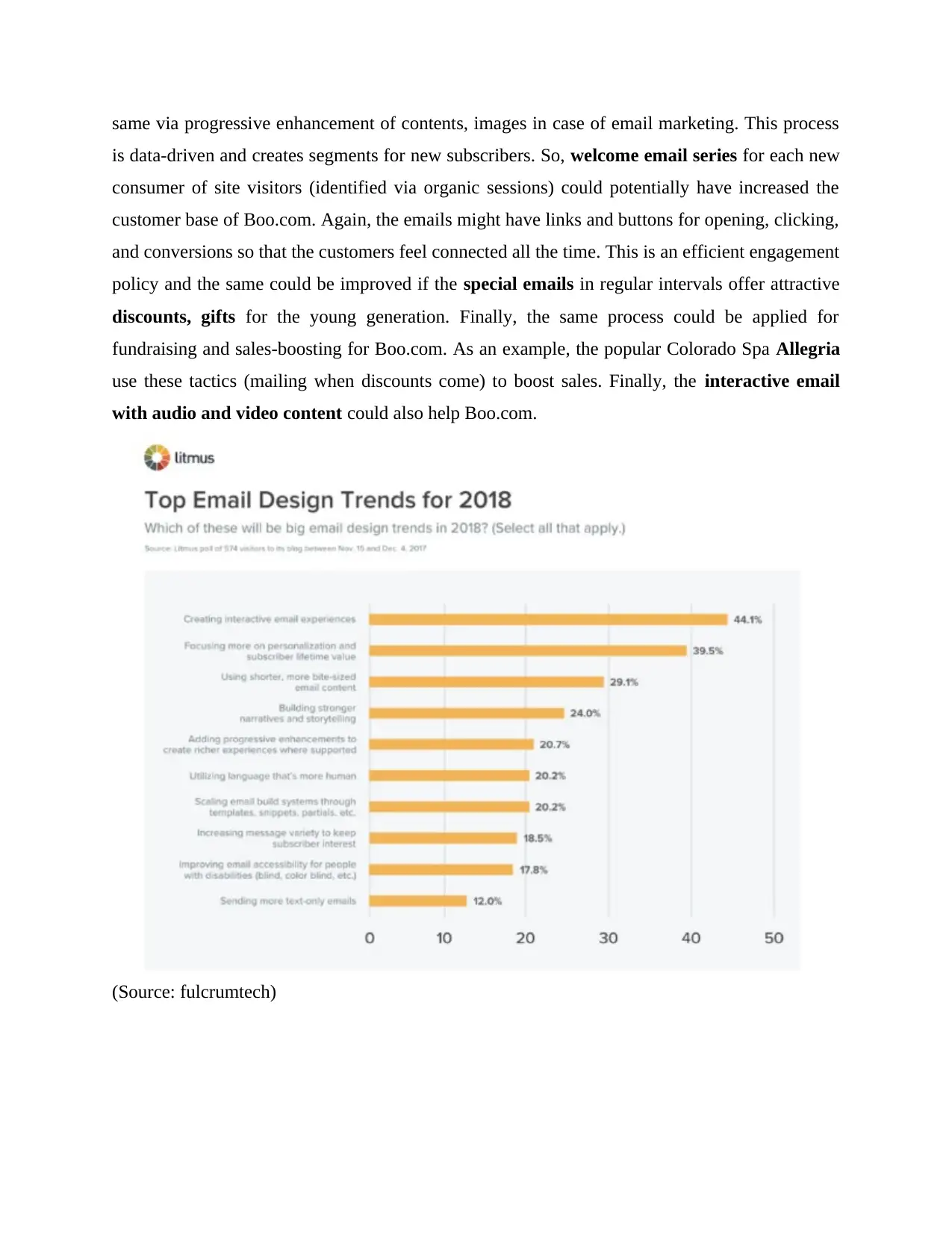
same via progressive enhancement of contents, images in case of email marketing. This process
is data-driven and creates segments for new subscribers. So, welcome email series for each new
consumer of site visitors (identified via organic sessions) could potentially have increased the
customer base of Boo.com. Again, the emails might have links and buttons for opening, clicking,
and conversions so that the customers feel connected all the time. This is an efficient engagement
policy and the same could be improved if the special emails in regular intervals offer attractive
discounts, gifts for the young generation. Finally, the same process could be applied for
fundraising and sales-boosting for Boo.com. As an example, the popular Colorado Spa Allegria
use these tactics (mailing when discounts come) to boost sales. Finally, the interactive email
with audio and video content could also help Boo.com.
(Source: fulcrumtech)
is data-driven and creates segments for new subscribers. So, welcome email series for each new
consumer of site visitors (identified via organic sessions) could potentially have increased the
customer base of Boo.com. Again, the emails might have links and buttons for opening, clicking,
and conversions so that the customers feel connected all the time. This is an efficient engagement
policy and the same could be improved if the special emails in regular intervals offer attractive
discounts, gifts for the young generation. Finally, the same process could be applied for
fundraising and sales-boosting for Boo.com. As an example, the popular Colorado Spa Allegria
use these tactics (mailing when discounts come) to boost sales. Finally, the interactive email
with audio and video content could also help Boo.com.
(Source: fulcrumtech)
Paraphrase This Document
Need a fresh take? Get an instant paraphrase of this document with our AI Paraphraser
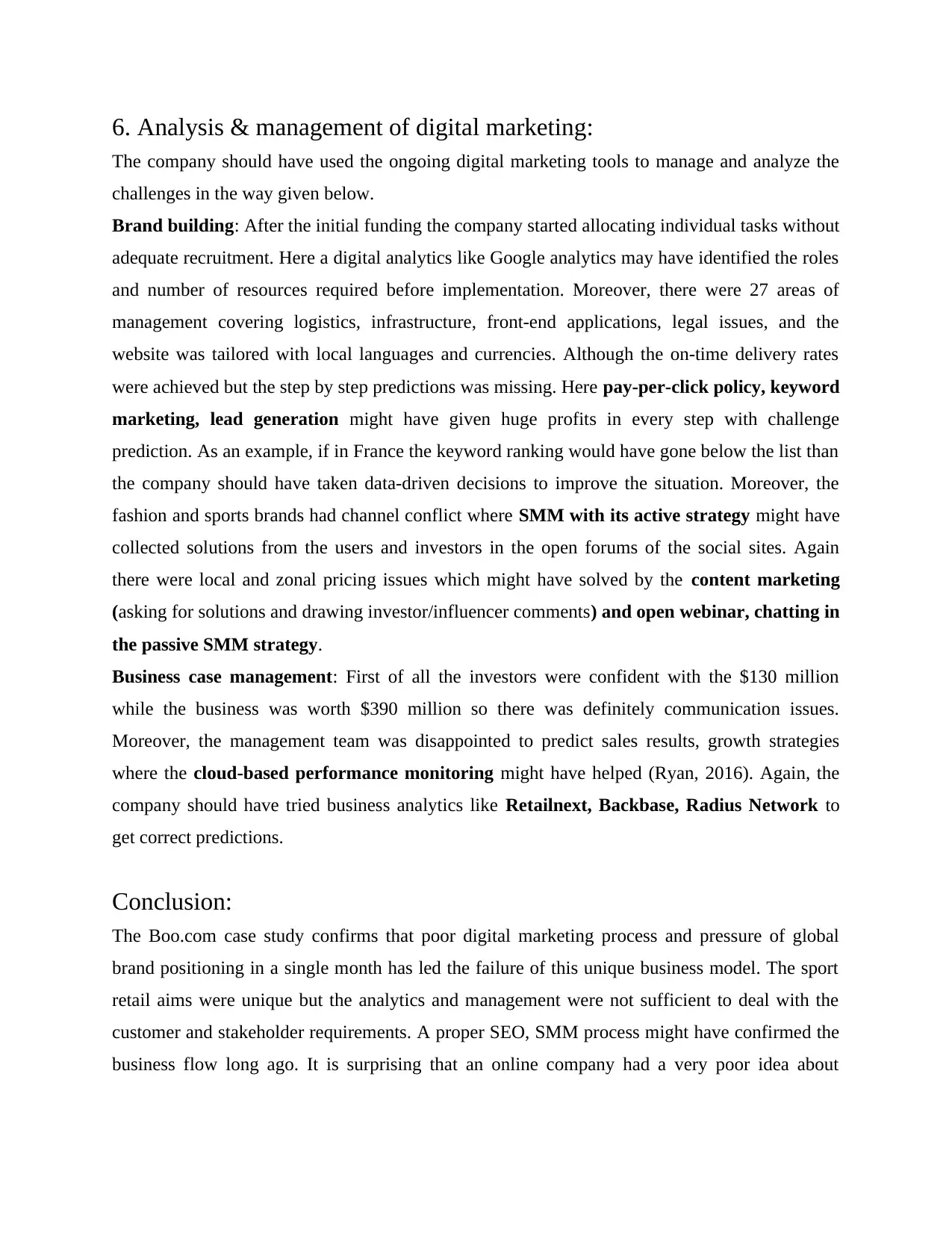
6. Analysis & management of digital marketing:
The company should have used the ongoing digital marketing tools to manage and analyze the
challenges in the way given below.
Brand building: After the initial funding the company started allocating individual tasks without
adequate recruitment. Here a digital analytics like Google analytics may have identified the roles
and number of resources required before implementation. Moreover, there were 27 areas of
management covering logistics, infrastructure, front-end applications, legal issues, and the
website was tailored with local languages and currencies. Although the on-time delivery rates
were achieved but the step by step predictions was missing. Here pay-per-click policy, keyword
marketing, lead generation might have given huge profits in every step with challenge
prediction. As an example, if in France the keyword ranking would have gone below the list than
the company should have taken data-driven decisions to improve the situation. Moreover, the
fashion and sports brands had channel conflict where SMM with its active strategy might have
collected solutions from the users and investors in the open forums of the social sites. Again
there were local and zonal pricing issues which might have solved by the content marketing
(asking for solutions and drawing investor/influencer comments) and open webinar, chatting in
the passive SMM strategy.
Business case management: First of all the investors were confident with the $130 million
while the business was worth $390 million so there was definitely communication issues.
Moreover, the management team was disappointed to predict sales results, growth strategies
where the cloud-based performance monitoring might have helped (Ryan, 2016). Again, the
company should have tried business analytics like Retailnext, Backbase, Radius Network to
get correct predictions.
Conclusion:
The Boo.com case study confirms that poor digital marketing process and pressure of global
brand positioning in a single month has led the failure of this unique business model. The sport
retail aims were unique but the analytics and management were not sufficient to deal with the
customer and stakeholder requirements. A proper SEO, SMM process might have confirmed the
business flow long ago. It is surprising that an online company had a very poor idea about
The company should have used the ongoing digital marketing tools to manage and analyze the
challenges in the way given below.
Brand building: After the initial funding the company started allocating individual tasks without
adequate recruitment. Here a digital analytics like Google analytics may have identified the roles
and number of resources required before implementation. Moreover, there were 27 areas of
management covering logistics, infrastructure, front-end applications, legal issues, and the
website was tailored with local languages and currencies. Although the on-time delivery rates
were achieved but the step by step predictions was missing. Here pay-per-click policy, keyword
marketing, lead generation might have given huge profits in every step with challenge
prediction. As an example, if in France the keyword ranking would have gone below the list than
the company should have taken data-driven decisions to improve the situation. Moreover, the
fashion and sports brands had channel conflict where SMM with its active strategy might have
collected solutions from the users and investors in the open forums of the social sites. Again
there were local and zonal pricing issues which might have solved by the content marketing
(asking for solutions and drawing investor/influencer comments) and open webinar, chatting in
the passive SMM strategy.
Business case management: First of all the investors were confident with the $130 million
while the business was worth $390 million so there was definitely communication issues.
Moreover, the management team was disappointed to predict sales results, growth strategies
where the cloud-based performance monitoring might have helped (Ryan, 2016). Again, the
company should have tried business analytics like Retailnext, Backbase, Radius Network to
get correct predictions.
Conclusion:
The Boo.com case study confirms that poor digital marketing process and pressure of global
brand positioning in a single month has led the failure of this unique business model. The sport
retail aims were unique but the analytics and management were not sufficient to deal with the
customer and stakeholder requirements. A proper SEO, SMM process might have confirmed the
business flow long ago. It is surprising that an online company had a very poor idea about
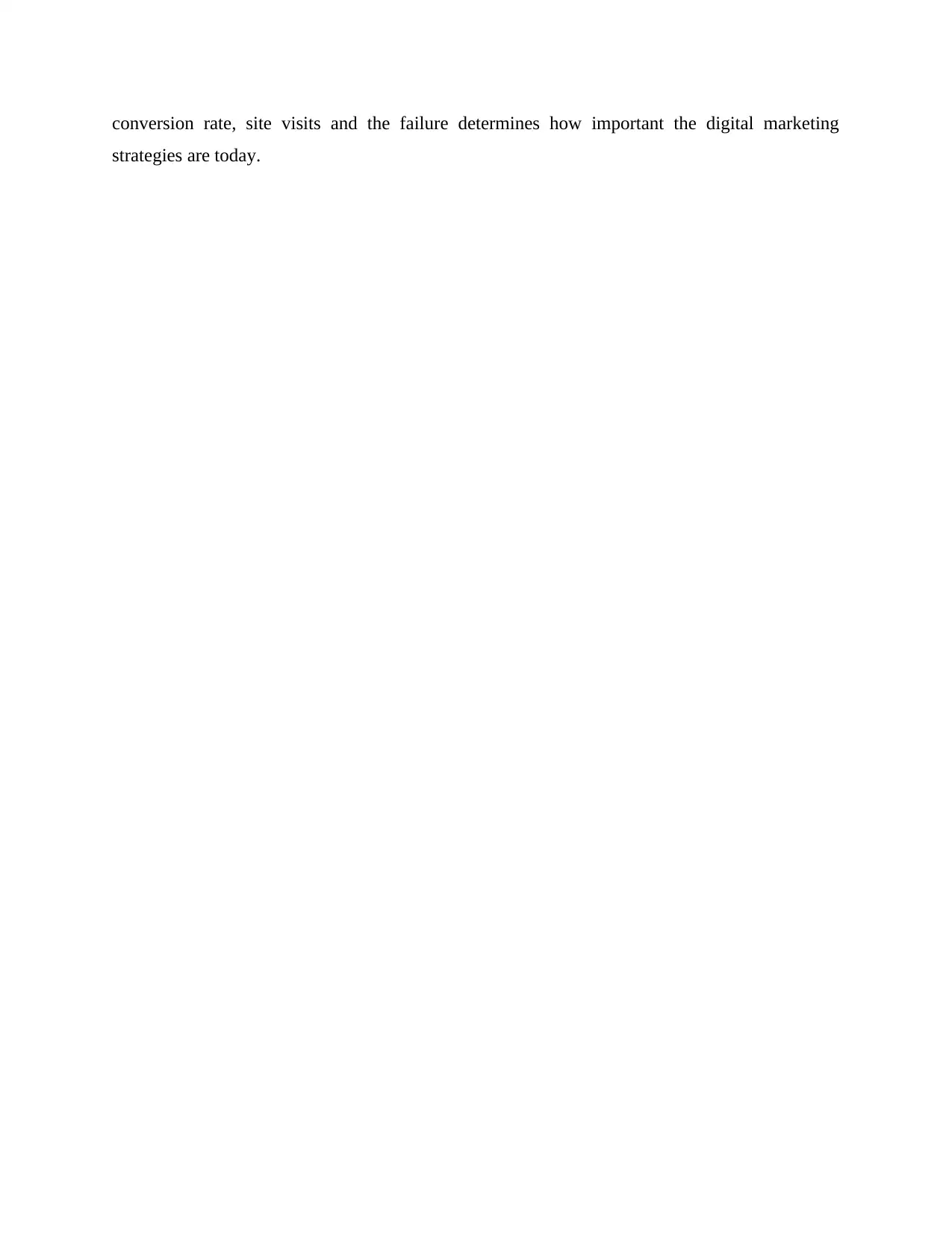
conversion rate, site visits and the failure determines how important the digital marketing
strategies are today.
strategies are today.
⊘ This is a preview!⊘
Do you want full access?
Subscribe today to unlock all pages.

Trusted by 1+ million students worldwide
1 out of 14
Related Documents
Your All-in-One AI-Powered Toolkit for Academic Success.
+13062052269
info@desklib.com
Available 24*7 on WhatsApp / Email
![[object Object]](/_next/static/media/star-bottom.7253800d.svg)
Unlock your academic potential
Copyright © 2020–2025 A2Z Services. All Rights Reserved. Developed and managed by ZUCOL.




